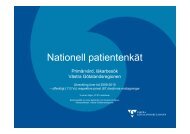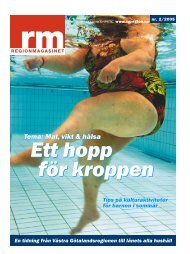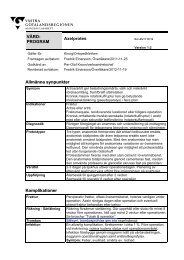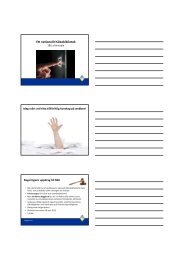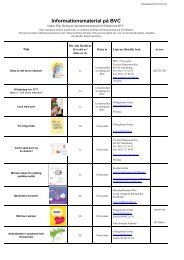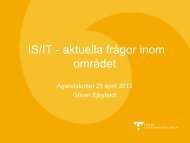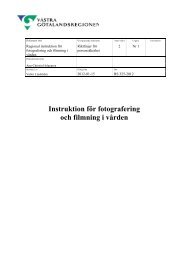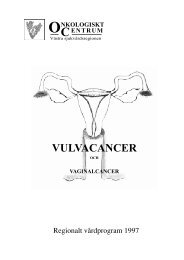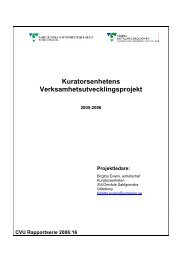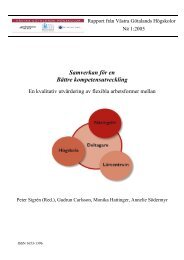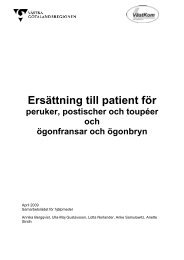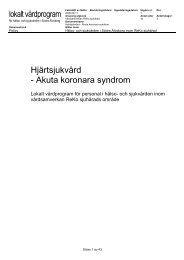FOURTEENTH ANNUAL EUROPEAN PRESSURE ULCER ...
FOURTEENTH ANNUAL EUROPEAN PRESSURE ULCER ...
FOURTEENTH ANNUAL EUROPEAN PRESSURE ULCER ...
Create successful ePaper yourself
Turn your PDF publications into a flip-book with our unique Google optimized e-Paper software.
Thursday September 1st<br />
Proceedings of the 14th Annual European Pressure Ulcer Meeting<br />
Oporto, Portugal<br />
Preventable hospital-acquired pressure ulcer prevalence in Western Australian Public<br />
Hospitals: Serial data 2007 - 2009<br />
Susannah Mulligan 1* , Jenny Prentice 2 , Keryln Carville 3 , Nick Santamaria 4<br />
1* WoundsWest, Australia, Susannah.Mulligan@health.wa.gov.au<br />
2 WoundsWest, Australia, 3 Silver Chain Nursing Association & Curtin University of Technology, Australia,<br />
4 University of Melbourne & Royal Melbourne Hospital, Australia<br />
Introduction<br />
This paper will describe methods used by<br />
WoundsWest to determine the epidemiology of<br />
preventable hospital-acquired pressure ulcers among<br />
patients admitted to public health facilities within<br />
Western Australia.<br />
Methods<br />
Annually between 2007 and 2009 all consenting inpatients<br />
of public hospitals and residential facilities<br />
attached to public hospitals in Western Australia<br />
underwent skin inspections to determine if they had a<br />
wound. Wounds were categorised into 6 groups:<br />
acute wounds, pressure ulcers, skin tears, burns,<br />
malignant and other wounds. Wounds not<br />
documented within 24 hours of admission were<br />
considered hospital-acquired. Teams of surveyors<br />
were educated and tested for competency in<br />
recognising and classifying wounds and conducting<br />
prevalence surveys to ensure consistency in audit and<br />
data collection methods.<br />
Results<br />
Approximately 8,900 patients were examined during<br />
the 3 annual prevalence surveys. Results identified a<br />
preventable hospital-acquired pressure ulcer<br />
prevalence of 8% in 2007 and 9% in 2008 compared<br />
to 6% prevalence in 2009. The data are highly<br />
comparable given the methodological rigour applied.<br />
Further results will be reported in terms of pressure<br />
ulcer prevention, compliance with work practices, and<br />
contextual data related to organisational wound<br />
management protocols, and equity and access to<br />
resources.<br />
94<br />
Discussion<br />
Between 2008 and 2009, WW demonstrated a 33%<br />
reduction in hospital-acquired pressure ulcers. This<br />
has saved WA Health a minimum of $3.8M due to a<br />
projection of 4,448 bed days saved over a 12-month<br />
period. Recommendations for continuing to lower<br />
preventable hospital-acquired pressure ulcers will be<br />
discussed.<br />
Data will also be compared to other Australian public<br />
hospital data.<br />
Clinical relevance<br />
Preventing hospital-acquired pressure ulcers improves<br />
patient outcomes, reduces length of stay and<br />
associated costs allowing scarce resources to be<br />
redirected to staff and patient education, clinical care<br />
and preventative strategies.<br />
Acknowledgements<br />
WoundsWest acknowledges the generous effort and<br />
commitment of staff and patients who contributed to<br />
the successful outcomes of WoundsWest’s 3 annual d<br />
Western Australian State-wide Wound Prevalence<br />
Surveys conducted between 2007 and 2009.<br />
Conflict of Interest<br />
Nil<br />
Copyright © 2011 by EPUAP



